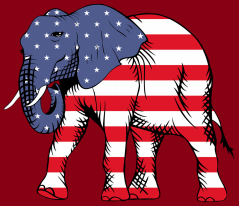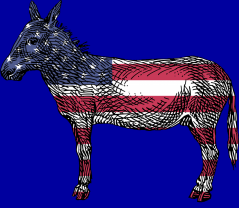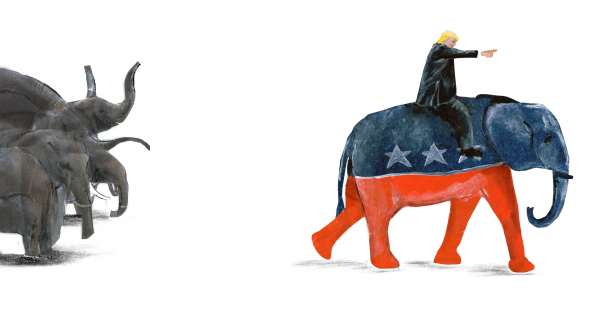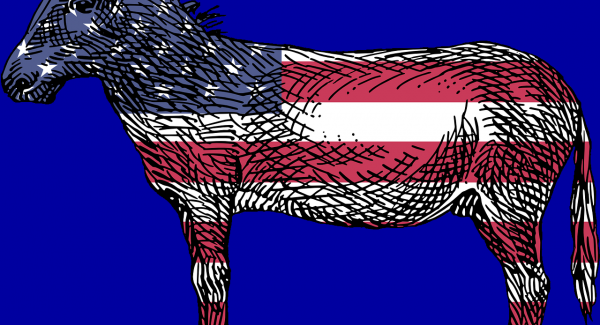While the opinions expressed in our own social networks may overwhelmingly predict our presidential candidate winning by a landslide, almost half of Americans polled support the candidate we oppose. As Democrats and Republicans have increasingly distanced themselves socially and physically from each other, we have found ourselves doubling down on our own moral superiority and demonizing anyone who doesn't agree with our point of view. This political polarization may help our own group in the short run, but leads to a host of negative downstream consequences—both for our own understanding of the world and for the nation’s success.
 Think about how bewildered you are that anyone in their right mind would vote for [insert Hilary Clinton or Donald Trump’s name here]. Now, go look at their current polling numbers. As of September 5th, 2016, Clinton has a slight lead over Trump, but both have support percentage ratings in the low 40s (Andrews, Katz, & Patel, 2016). Somehow, despite the fact that you may not know anyone who is planning on voting for them (other than that crazy relative you don’t talk to), almost half of Americans polled support the candidate you oppose.
Think about how bewildered you are that anyone in their right mind would vote for [insert Hilary Clinton or Donald Trump’s name here]. Now, go look at their current polling numbers. As of September 5th, 2016, Clinton has a slight lead over Trump, but both have support percentage ratings in the low 40s (Andrews, Katz, & Patel, 2016). Somehow, despite the fact that you may not know anyone who is planning on voting for them (other than that crazy relative you don’t talk to), almost half of Americans polled support the candidate you oppose.
We see people on our side as righteous and brave and people on the other side as either uninformed, stupid, or even downright evil. As with so many moral conflicts before, it is like a wall has come up between the two ideological camps.
Recently, this wall that comes up in moral conflicts has been increasingly contributing to animosity and gridlock between the two ideological poles in the United States for both the political elite and the overall population. Government is the most polarized that it has been since the American Civil War, leading to record high numbers of filibusters and plummeting numbers of moderate congresspersons (United States Senate, 2016; VoteView.com, 2016). This trend directly parallels the growing partisan divide between the values and ideological beliefs endorsed by Americans who identify as Democrats and Republicans (Pew Research Center, 2012). Now more than ever, we are choosing to physically sort ourselves into moral and political enclaves, which has led to most congressional districts becoming either overwhelmingly “blue” or “red” (Motyl et al., 2014). Liberals or left-leaning individuals are moving to urban centers for political reasons, and conservatives or right-leaning individuals are avoiding them to keep away from the liberals (Silver, 2012). With cable TV, internet, and social media now providing hundreds of explicitly partisan news sources which tailor to their specific audiences, we are also choosing our media consumption based on the partisan reputation (e.g., Fox News, The Daily Show).
This self-sorting into ideological camps has resulted in a majority of Americans polled reporting fearful and very unfavorable views of those belonging to the opposing party (Pew Research Center, 2016). Partisan selective exposure in media consumption has led to greater political polarization of the general public (Levendusky, 2013; Stroud, 2010). At all levels of society, we are doubling down on our own group’s moral superiority and punishing anyone who works with the other side as a traitor.
The negative ramifications of political polarization
 But if those other guys are wrong, we are right, and we don’t like them anyway, why should we care? Remember how you don’t know many people who would vote for [Clinton/Trump], and yet somehow 40% or more of Americans’ polled support them?
But if those other guys are wrong, we are right, and we don’t like them anyway, why should we care? Remember how you don’t know many people who would vote for [Clinton/Trump], and yet somehow 40% or more of Americans’ polled support them?
Political polarization is making us less accurate and knowledgeable about the world. Political polarization results in an incomplete picture of political events and information and increases our exposure and susceptibility to misinformation (Del Vicario et al., 2015). We selectively believe information when it supports how we already feel about the topic, perceiving people from the opposing ideological camp as biased and ignoring “the facts” (Ditto & Liu, 2012). Repeated exposure to the same information within our ideological echo chambers increases our belief that the information is true and keeps us from questioning whether or not the information or our understanding of it is accurate (Allport & Lepkin, 1945). Researchers have found that people who are more ideologically partisan are also more likely to overestimate the amount of knowledge they have about a topic (Fernbach et al., 2013). Even when we are confronted with strong information that contradicts our beliefs, we frequently respond by digging in and believing in our stance even more (for an overview, see Feinholdt, 2014).
Polarization is making us less empathic and more violent. In addition to making us less factually accurate and thoughtful, political polarization and partisan selective exposure justifies and increases intergroup violence through a process called dehumanization (Crawford, Modri, & Motyl, 2013; Crawford, 2014). By cultivating caricatures of opponents as evil, dumb or completely devoid of any positive human qualities (Lewandowski et al., 2013), we paint partisans of the opposing side as worse than enemies; they’re inhuman. Political scientists have found that people are now more likely to explicitly discriminate against others based on political party affiliation than they are based on race (Iyengar & Westwood, 2015). This outgroup hate is leading us to react to each other violently out of fear (Iyengar, Sood, & Lelkes, 2012). Protesters rioting and throwing eggs at Trump supporters at a rally in San Jose and supporters pepper spraying protesters outside a rally in San Diego, amongst other violent clashes, have all been attributed to rising political polarization in the U.S (Elving, 2106). While this discrimination may seem ok when you are surrounded by ideologically similar others, it will be strikingly problematic when you find yourself in the midst of the opposing camp.
Polarization making us less politically effective. Finally, the end result of a lack of political diversity within our immediate social networks is an inability for our communities and government to function as they were intended. Politically polarized districts have lower rates of voter turnout (Rogowski, 2014), and lawmakers’ unwillingness to compromise increases to the extent that their voters don’t weigh bipartisanship as a factor for re-election. When a single political party is endorsed by the majority of the population in a district, political candidates’ only competition is their primary election competitor. In these cases, politicians are incentivized to become more extreme to out-compete each other in the primaries, which decreases the number of moderates in Congress and makes bipartisan collaboration punishable in the next election cycle (VoteView.com, 2016).
With fewer moderates to reach across the aisle comes higher political gridlock, larger and larger portions of the legislative agenda is left unresolved (Bishop, 2000). Liberals protest and vilify the Republican-dominant Wisconsin Legislature for limiting collective bargaining rights without Democratic support, but believe that the unilateral passing of the Patient Protection and Affordable Care Act (also known as “Obamacare”) by Democrats in Congress as being necessary due to a lack of compromise from their conservative counterparts. Our moral outrage when our opponents push something through legislature without bipartisan support is staggering, but when our side does it we see it as a necessary countermeasure for the good of the country. Even when the majority of the population agrees on something, Congress is unable to make progress. The Senate has continued to reject bills that include background check measures for gun sales, despite bipartisan public support for these measures steadily holding at over 80% (79% of Republicans, 88% of Democrats; Pew Research Center, 2015).
Ok, it’s a problem, and it’s getting worse. What can we do?
Recognize your own biases. We all suffer from what psychologists call naïve realism, or the belief that our interpretation of the world is objective and unbiased, but other people’s viewpoints are either biased, irrational, or both (Nasie et al., 2014). The first step in overcoming political polarization is admitting that we too are biased, and that our understanding of the world is probably at least a little bit false. Each side is morally motivated, and we all must beware our own sacred values. Next time you respond to someone else’s viewpoint with an immediate viscerally negative reaction, ask yourself if your prior beliefs may interfere with accurate perceptions.
Reduce threatening interactions. Think about the last time that you had a serious argument with someone and told them they were 100% wrong. Whether it was your friend, child, parent, or romantic partner, odds are that they immediately went on the defensive, the argument escalated, and nothing positive was resolved. Why do we think this tactic will work with opposing partisans we don’t know personally, when it doesn’t even work with our closest friends and family who care about us? Only by showing respect for our debate partner and acknowledging that their feelings and beliefs are a part of the conversation can we begin to bridge the partisan gap. By fostering positive social interactions between partisans, interventions based in social psychology’s Intergroup Contact Theory have successfully decreased demonization of outgroup members and increased intergroup cooperation (Allport, 1954; Iyer, 2016; Pettigrew & Trope, 2006).
Appeal to emotions and perspective take. Most people, and certainly more U.S. citizens, regardless of political stance, have the same life goals that we do but believe in different ways of achieving those goals. The best way to be attentive to your own biases while also persuading someone who disagrees with you is to employ perspective-taking. Understanding the basis of your opponent’s argument helps you to both show that you are able to see the issue from their side and to tailor your argument to fit their belief system (Tuller et al., 2015). Appeals that invoke value concerns that are relevant to the opposing party are much more effective at shifting policy perceptions and beliefs than appeals from your own point of view (Feiberg & Willer, 2015).
Support governmental reforms and bipartisanship. At the legislative level, politician polarization will decrease when it becomes disadvantageous to be extreme. One way to decrease the attractiveness of extremity is by supporting open or semi-open primaries. By allowing independents and moderates to vote in primaries, candidates must account for the appeal of their policy stances to a broader audience (Epstein & Graham, 2007). Additionally, increase attention to and positively reinforce bipartisan action on the part of legislators. Websites like govtrack.us have begun to provide yearly information about bipartisanship for all members of the Senate and House of Representatives, which can help in the endeavor to hold our pundits accountable.
Overall, while it may feel good in the short run to isolate ourselves from partisans on the other side of the ideological divide, the long term consequences of political homogeneity are dire. We have to ask ourselves, is the short term gain to be had through violent enforcement of one viewpoint more important than the long term success and well-being of our nation as a whole?
References
Allport, G. W. (1954). The Nature of Prejudice. Cambridge, MA: Perseus Books.
Allport, F. H., & Lepkin, M. (1945). Wartime rumors of waste and special privilege: why some people believe them. Journal of Abnormal & Social Psychology, 40(1), 3-36.
Andrews, W., Katz, J., & Patel, J. (2016, September 5). Latest election polls 2016. The New York Times. Retrieved from www.nytimes.com/interactive/2016/us/elections/polls.html?_r=0
Crawford, J. (2014, March 28). Bleeding-heart liberals and hard-hearted conservatives: Political dehumanization in the United States. The Inquisitive Mind. Retrieved from http://www.in-mind.org/blog/post/bleeding-heart-liberals-and-hard-hearted-conservatives-political-dehumanization-in-the
Crawford, J.T., Modri, S.A., & Motyl, M. (2013). Bleeding-heart liberals and hard-hearted conservatives: Subtle political dehumanization through differential attributions of human nature and human uniqueness traits. Journal of Social and Political Psychology, 1(1), 86-104. doi: 10.5964/jspp.v1i1.184
Del Vicario, M., Bessi, A., Zollo, F., Petroni, F., Scala, A., Caldarelli, G., Stanley, H. E., & Quattroiciocchi W. (2016). The spreading of misinformation online. PNAS, 113(3), 554-559.
Ditto, P. H., & Liu, B. S. (2012). What dilemma? Moral evaluation shapes factual beliefs. Social Psychological and Personality Science, 4(3), 316-323.
Elving, R. (2016, March 14). A campaign on the brink: Donald Trump and the intersection of outrage and violence. NPR. Retrieved from http://www.npr.org/2016/03/14/470375065/a-campaign-on-the-brink-donald-trump-and-the-intersection-of-outrage-and-violenc
Epstein, D., & Graham, J. D. (2007). Polarized politics and policy consequences. Santa Monica, CA: RAND Corporation
Fernbach, P. M., Rogers, T., Fox, C. R., & Sloman, S. A. (2013). Political extremism is supported by an illusion of understanding. Psychological Science, 24, 939-946.
Feinberg, M., & Willer, R. (2015). From gulf to bridge: When do moral arguments facilitate political influence? Personality and Social Psychology Bulletin, 41(12), 1665-1681.
Feinholdt, A. (2014, October 31). Never give up: The persistence of misinformation effects. The Inquisitive Mind. Retrieved from http://www.in-mind.org/blog/post/never-give-up-the-persistence-of-misinformation-effects
Fleisher R., & Bond J. R. (2004). The shrinking middle in the U.S. Congress. British Journal of Political Science, 34, 429–51.
Iyengar, S., Sood, G., & Lelkes, Y. (2012). Affect, not ideology a social identity perspective on polarization. Public Opinion Quarterly, 76(3), 405-431.
Iyengar, S., & Westwood, S. J. (2014). Fear and loathing across party lines: New evidence on group polarization. American Journal of Political Science, 59(3), 690-707.
Iyer, R. (2016). The village square helps liberals understand that conservatives are indeed good people too. CivilPolitics.org. Retrieved from http://www.civilpolitics.org/content/the-village-square-liberals-conservatives-are-good-people-too/
Lewandowsky, S., Stritzke, W. G., Freund, A. M., Oberauer, K., & Krueger, J. I. (2013). Misinformation, disinformation, and violent conflict: From Iraq and the “War on Terror” to future threats to peace. American Psychologist, 68(7), 487-501.
Motyl, M., Hart, J., Pyszczynski, T., Weise, D., Cox, C., Maxfield, M., & Siedel, A. (2011). Subtle priming of shared human experiences eliminates threat-induced negativity toward Arabs, immigrants, and peace-making. Journal of Experimental Social Psychology, 47, 1179-1184.
Motyl, M., Iyer, R., Oishi, S., Trawalter, S., & Nosek, B. A. (2014). How ideological migration geographically segregates groups. Journal of Experimental Social Psychology, 51, 1-14.
Nasie, M., Bar-Tal, D., Pliskin, R., Nahhas, E., Haperin, E., (2014) Overcoming the barrier of narrative adherence in conflicts through awareness of the psychological bias of naive realism. Personal and Social Psychology Bulletin, 40, 1543-1557.
Pettigrew, T. F., & Tropp, L. R. (2006). A meta-analytic test of intergroup contact theory. Journal of Personality and Social Psychology, 90, 751-783.
Pew Research Center (June 12, 2014) Political polarization in the American public. Pew Research Center. Retrieved from http://www.people-press.org/2014/06/12/political-polarization-in-the-american-public/#
Pew Research Center (2015, August 13). Continued bipartisan support for expanded background checks on gun sales. Pew Research Center. Retrieved from http://www.people-press.org/2015/08/13/continued-bipartisan-support-for-expanded-background-checks-on-gun-sales/
Pew Research Center (June 22, 2016). Partisanship and political animosity in 2016. Pew Research Center. Retrieved from http://www.people-press.org/2016/06/22/partisanship-and-political-animosity-in-2016/
Rogowski, J. C. (2014). Electoral choice, ideological conflict, and political participation. American Journal of Political Science, 58(2), 479-494.
Silver, N. (2012, December 27). As swing districts dwindle, can a divided house stand? The New York Times. Retrieved from http://fivethirtyeight.blogs.nytimes.com/2012/12/27/as-swing-districts-dwindle-can-a-divided-house-stand/
Stroud, N. J. (2010). Polarization and partisan selective exposure. Journal of Communication, 60(3), 556-576.
United States Senate (2016). Senate action on cloture motions. Retrieved from http://www.senate.gov/pagelayout/reference/cloture_motions/clotureCounts.htm
Tuller, H. M., Bryan, C. J., Heyman, G. D., & Christenfeld, N. J. (2015). Seeing the other side: Perspective taking and the moderation of extremity. Journal of Experimental Social Psychology, 59, 18-23.



